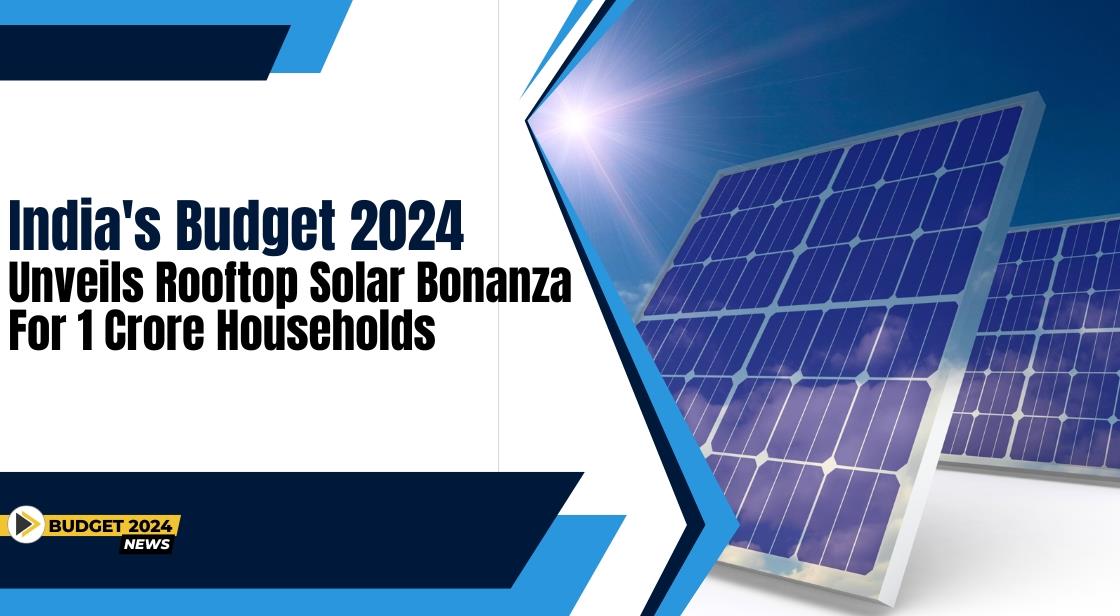India's Budget 2024 Unveils Rooftop Solar Bonanza for 1 Crore Households

News Synopsis
In a significant move during the interim budget presentation, Finance Minister Nirmala Sitharaman unveiled a set of initiatives aimed at propelling India's renewable energy agenda. Among these, a noteworthy initiative seeks to benefit one crore households by providing up to 300 units of free electricity monthly through rooftop solarisation.
Rooftop Solarisation for One Crore Households:
Finance Minister Sitharaman, during the budget announcement, shed light on the rooftop solarisation project. The initiative aims to empower one crore households, ensuring they receive 300 units of free electricity every month. The Finance Minister connected this scheme to Prime Minister Narendra Modi's declaration on January 22, following his visit to Ayodhya, where he announced the launch of the Pradhan Mantri Suryoday Yojna in one crore houses.
Anticipated Benefits of Solarisation:
The government envisions numerous advantages stemming from the rooftop solarisation initiative. These include substantial annual savings for households, estimated between Rs 15,000-18,000 crore, owing to free solar electricity. Additionally, surplus energy can be sold to distribution companies, thereby contributing to annual savings.
The initiative is expected to facilitate electric vehicle charging, create entrepreneurial opportunities for supply and installation vendors, and generate employment for skilled youth in manufacturing, installation, and maintenance.
Finance Minister Sitharaman emphasized, "Expected benefits include annual household savings of Rs 15,000-18,000 from free solar electricity and selling surplus to distribution companies."
Key Highlights of the Pradhan Mantri Suryoday Yojna:
-
Empowering 1 Crore Households: One crore households across India will gain access to free electricity and the ability to generate their own clean energy through rooftop solar panels.
-
Financial Savings and Sustainability: Participants are expected to save Rs 15,000-18,000 annually through reduced electricity bills and selling excess power back to the grid, promoting a sustainable energy future.
-
Boosting the Economy: The program is projected to create entrepreneurial opportunities for supply and installation vendors, generate employment in manufacturing, installation, and maintenance, and contribute to India's green growth.
-
EV Charging and More: The generated solar power can also be used for electric vehicle charging, further supporting India's electric mobility goals.
Renewable Energy Focus and Viability Gap Funding:
Aligned with the objective of achieving 'net-zero' by 2070, Sitharaman proposed viability gap funding to tap into offshore wind energy potential, beginning with an initial capacity of one gigawatt. The budget also outlines plans for the establishment of coal gasification and liquefaction capacity of 100 MT by 2030, aiming to reduce imports of natural gas, methanol, and ammonia.
Measures for Compressed Bio Gas (CBG) and Electric Vehicles:
The budget introduces phased mandatory blending of Compressed Bio Gas (CBG) in Compressed Natural Gas (CNG) for transportation and Piped Natural Gas (PNG) for domestic purposes. Financial assistance is set to be extended for the procurement of biomass aggregation machinery. In the electric vehicle domain, Sitharaman reiterated the government's commitment to expanding the e-vehicle ecosystem, supporting manufacturing, charging infrastructure, and encouraging greater adoption of e-buses in public transport networks through a payment security mechanism.
Green Growth Initiatives:
To foster green growth, the budget proposes a novel scheme for bio-manufacturing and bio-foundry. This initiative aims to promote environmentally friendly alternatives such as biodegradable polymers, bio-plastics, bio-pharmaceuticals, and bio-agri-inputs. Sitharaman emphasized that this scheme is poised to transform the current consumptive manufacturing paradigm into one based on regenerative principles.
Beyond Rooftop Solar: A Multifaceted Approach to Green Energy
The 2024 budget goes beyond rooftop solar, outlining a comprehensive strategy for India's clean energy future:
-
Offshore Wind Energy: Viability gap funding will be allocated to harness the potential of offshore wind energy, with an initial target of 1 gigawatt capacity.
-
Reducing Natural Gas Dependence: Plans are underway to establish coal gasification and liquefaction capacity of 100 MT by 2030, aimed at reducing reliance on imported natural gas, methanol, and ammonia.
-
Biogas Integration: Phased mandatory blending of Compressed Bio Gas (CBG) in CNG and PNG will promote the use of clean, domestically produced fuel.
-
Electric Vehicles: The government remains committed to expanding the e-vehicle ecosystem by supporting manufacturing, charging infrastructure, and encouraging e-bus adoption in public transport.
-
Bio-manufacturing and Bio-foundry: A novel scheme will promote environmentally friendly alternatives like biodegradable polymers and bio-pharmaceuticals, fostering green growth and a more sustainable future.
You May Like









